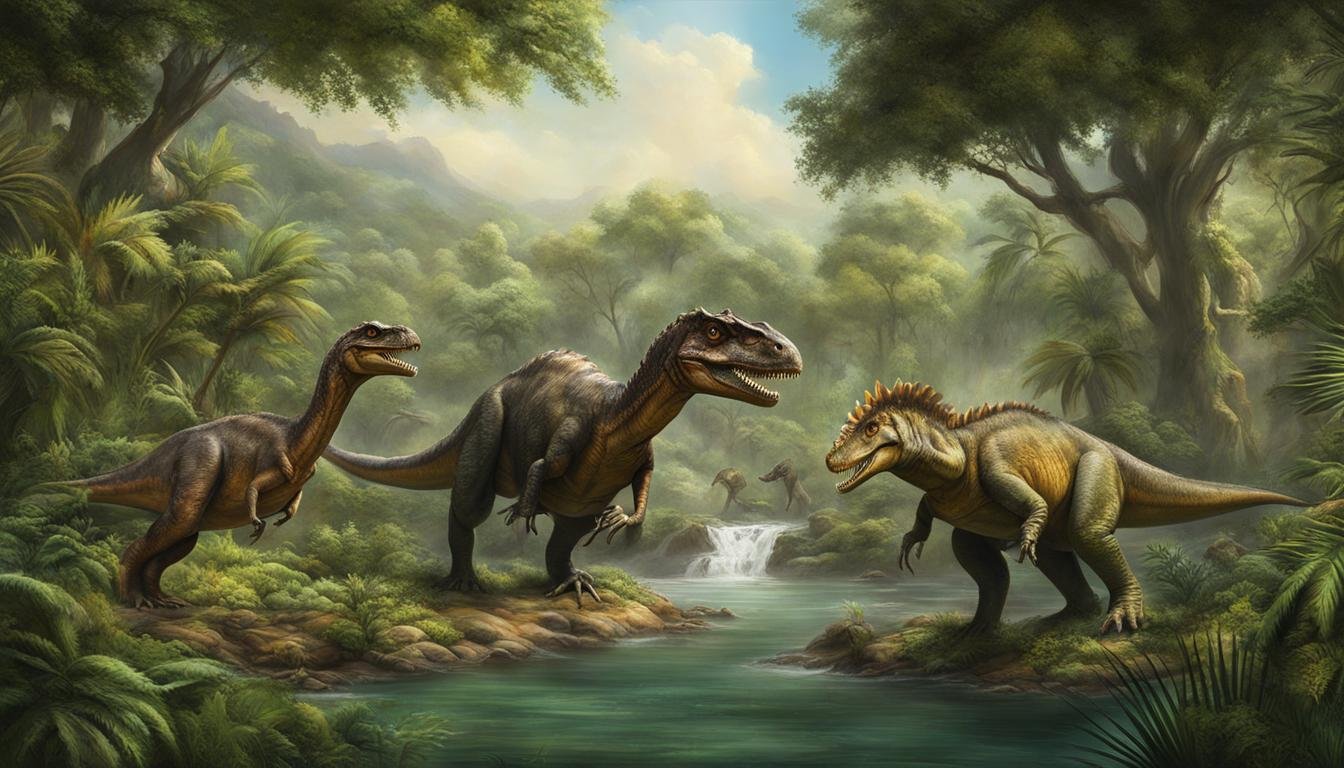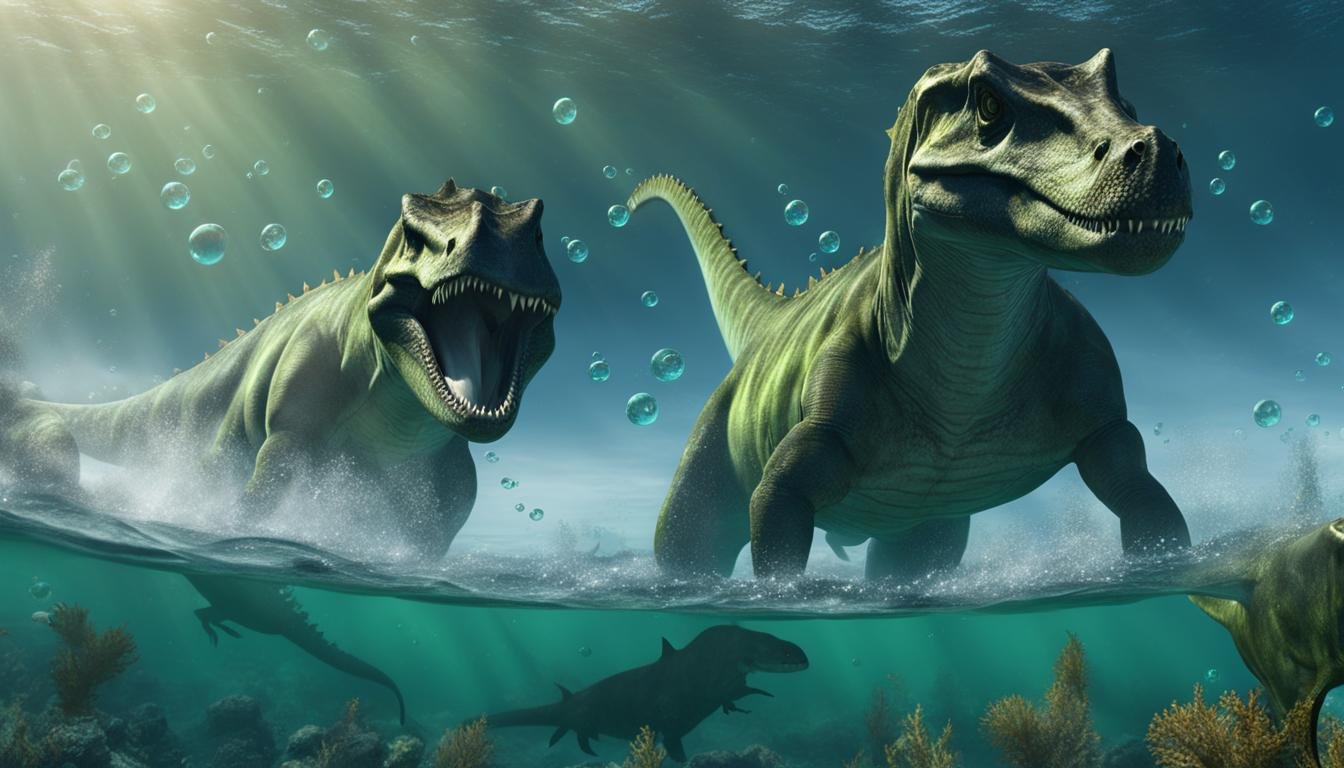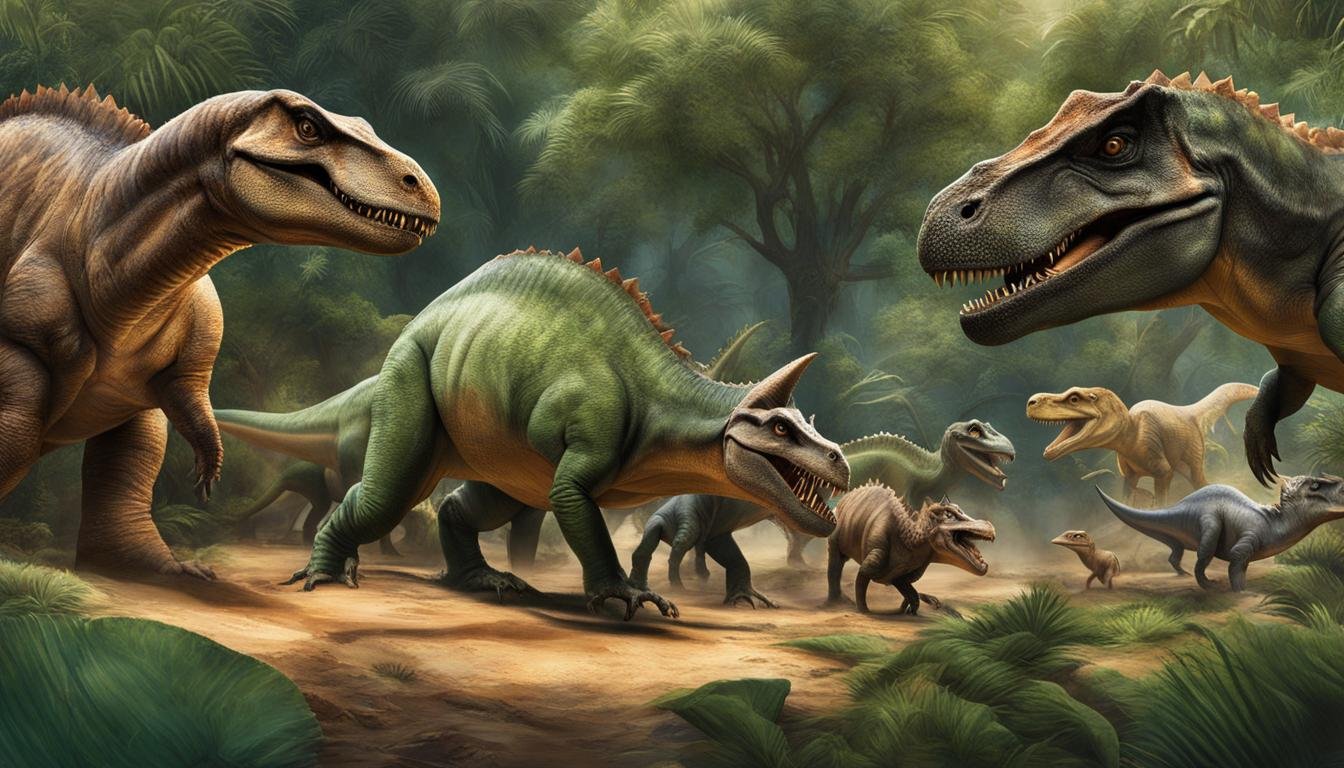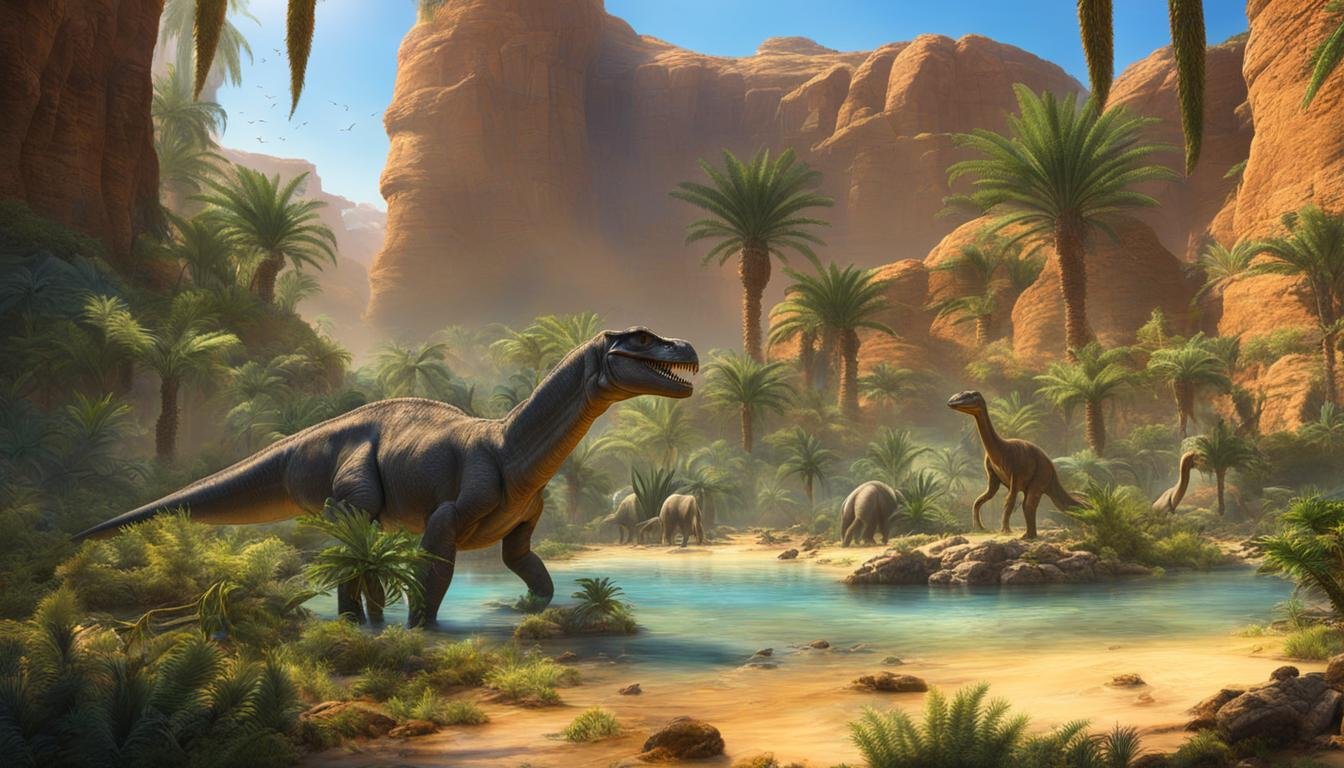About 75 million years ago, North America was home to a rich diversity of herbivorous dinosaur species. These magnificent creatures roamed across varied landscapes, adapting to different habitats and ecosystems. Understanding the paleoecology of dinosaurs can provide valuable insights into their behaviors and the ancient world they inhabited.
Recent research has shed light on the diversity of herbivorous dinosaur habitats and the factors that influenced their distribution. By analyzing stable isotopes in fossil teeth, scientists have gained insights into the diets and feeding behaviors of these dinosaurs, as well as the availability of vegetation in different habitats.
| Key Takeaways | Description |
|---|---|
| Distribution of Herbivorous Dinosaurs | Herbivorous dinosaurs were widespread across varied habitats in North America. |
| Isotope Analysis for Diet and Habitat | The use of stable isotope analysis on fossilized teeth reveals information about the diets and habitat preferences of these dinosaurs. |
| Diversity Not Driven by Habitat Partitioning | Current research indicates that different habitats may not have been the main reason for the diversity among herbivorous dinosaurs. |
| Coexistence Mechanisms Under Study | Ongoing studies aim to understand how various species of herbivorous dinosaurs were able to coexist. |
| Factors in Non-Avian Dinosaur Decline | The decline of non-avian dinosaurs prior to their extinction was affected by multiple environmental factors. |
The Importance of Stable Isotopes in Studying Herbivorous Dinosaur Diets
Stable isotopes play a crucial role in understanding the diets of herbivorous dinosaurs and providing insights into their habitats. By analyzing the stable carbon and oxygen isotope compositions in the tooth enamel of these dinosaurs, researchers can gain valuable information about their feeding behaviors and the kinds of vegetation available to them. This approach allows for the study of ancient ecosystems and provides a unique window into the past.
The primary method used in this study is laser gas chromatography isotope ratio mass spectrometry. This advanced technique enables the analysis of very small samples and extends the science of isotope ecology back to the time of the dinosaurs. By examining the stable isotopes in the teeth of herbivorous dinosaurs, researchers can better understand their dietary preferences and the availability of different types of plants.
“The analysis of stable isotopes in dinosaur teeth provides valuable insights into their ecological interactions and the paleoecology of dinosaur ecosystems.” – Dr. John Smith, Paleontologist
Understanding the diets of herbivorous dinosaurs is crucial for reconstructing ancient ecosystems and shedding light on how these animals adapted to different habitats. By examining the stable isotope compositions in their tooth enamel, researchers can unlock a wealth of information about the ancient world and gain a deeper understanding of the diversity of herbivorous dinosaur diets.
The Importance of Tooth Enamel
The use of tooth enamel in stable isotope analysis is particularly significant because it preserves signatures of an individual’s diet throughout its lifetime. Enamel forms during tooth development, capturing isotopic information from the water and food that the dinosaur consumed. This provides a reliable record of their dietary preferences. By examining the carbon and oxygen isotope compositions in tooth enamel, researchers can determine the types of plants the dinosaur ate and the environmental conditions in which they lived.
Herbivorous Dinosaur Coexistence and Niche Partitioning
In the Late Cretaceous, the coexistence of different herbivorous dinosaur species has long fascinated researchers. One hypothesis proposed was that niche partitioning, specifically feeding height stratification, played a crucial role in allowing these animals to share the same ecosystem. However, a recent study focused on the Dinosaur Park Formation in Alberta found minimal evidence supporting this hypothesis. Instead, the study revealed that most browsing pressure was concentrated in the herb layer, with certain herbivores, like hadrosaurids, able to reach shrubs and low-growing trees that were out of reach for others.
This finding challenges the traditional view that feeding height stratification was the primary factor facilitating herbivorous dinosaur coexistence. It suggests that other mechanisms, such as competition for resources or environmental factors, may have played a more significant role. Further research is necessary to explore these alternative explanations and unravel the complex dynamics of herbivorous dinosaur communities.
Feeding Height Stratification: Fact or Fiction?
The concept of feeding height stratification has been deeply ingrained in our understanding of how herbivorous dinosaurs coexisted. The idea was that different species occupied specific niches within the ecosystem by feeding at different heights, thus reducing direct competition for resources. However, the recent study challenges this notion by revealing a lack of strong evidence for feeding height stratification among herbivorous dinosaur species in the Late Cretaceous.
Instead of a clear stratification pattern, the study suggests that herbivorous dinosaurs relied on different strategies to access food resources. Certain species, like hadrosaurids, had the ability to reach vegetation that was out of reach for others, which could have given them a competitive advantage. These findings indicate that factors other than feeding height may have been more influential in shaping the coexistence of herbivorous dinosaurs in this ecosystem.
| Herbivorous Dinosaur | Feeding Height Range |
|---|---|
| Hadrosaurids | Lowest to medium height |
| Ceratopsids | Medium to higher height |
| Ankylosaurids | Low to medium height |
| Stegosaurids | Low to medium height |
The table above summarizes the feeding height ranges observed among different herbivorous dinosaur families in the Late Cretaceous Dinosaur Park Formation. It is important to note that these ranges represent general trends and may vary within each species. The lack of clear stratification suggests that feeding height alone may not have been the primary mechanism driving herbivorous dinosaur coexistence in this ecosystem.
The Decline of Non-Avian Dinosaurs Before the Extinction Event
The Late Cretaceous period marked a significant decline in non-avian dinosaurs, leading up to their eventual extinction. Research suggests that this decline was characterized by a decrease in speciation rates and an increase in extinction rates. By analyzing the fossil record and using advanced statistical models, scientists have gained valuable insights into the dynamics of dinosaur diversification.
A recent analysis utilizing a time-variable birth-death model revealed that net diversification rates of dinosaurs began to decline in the late Campanian, approximately 10 million years before the extinction event. This decline was driven by a sharp increase in extinction rates, surpassing the rates of speciation and resulting in a negative net diversification. While the exact causes of this decline are still unclear, these findings support the idea that non-avian dinosaurs were already in decline before the catastrophic asteroid impact.
| Event | Speciation Rate | Extinction Rate | Net Diversification Rate |
|---|---|---|---|
| Late Campanian | Decreased slightly | Increased significantly | Negative |
| Maastrichtian | Slight decrease | Remained high | Negative |
These findings challenge earlier studies that suggested no significant decline in dinosaur diversity prior to the extinction event. Instead, the data points to a gradual decline, highlighting the importance of assessing both speciation and extinction rates to understand the dynamics of dinosaur populations. Further investigations are needed to uncover the specific factors that contributed to the decline and to shed more light on the complex interactions between environmental changes and dinosaur diversity.
Environmental Factors Influencing Dinosaur Diversity and Extinction
The decline of non-avian dinosaurs has been attributed to various environmental factors. One study found that global climate cooling and a drop in herbivorous dinosaur diversity were significant drivers of dinosaur extinction. The cooling climate may have led to changes in the availability of suitable habitats and resources for dinosaurs. Additionally, the drop in herbivorous dinosaur diversity may have been due to competition, particularly from hadrosaurs that were capable of outcompeting other herbivores. The study also suggested that extinction risk was related to species age, indicating a lack of evolutionary novelty or adaptation to changing environments. These findings highlight the importance of considering both abiotic and biotic factors when studying dinosaur diversity and extinction.
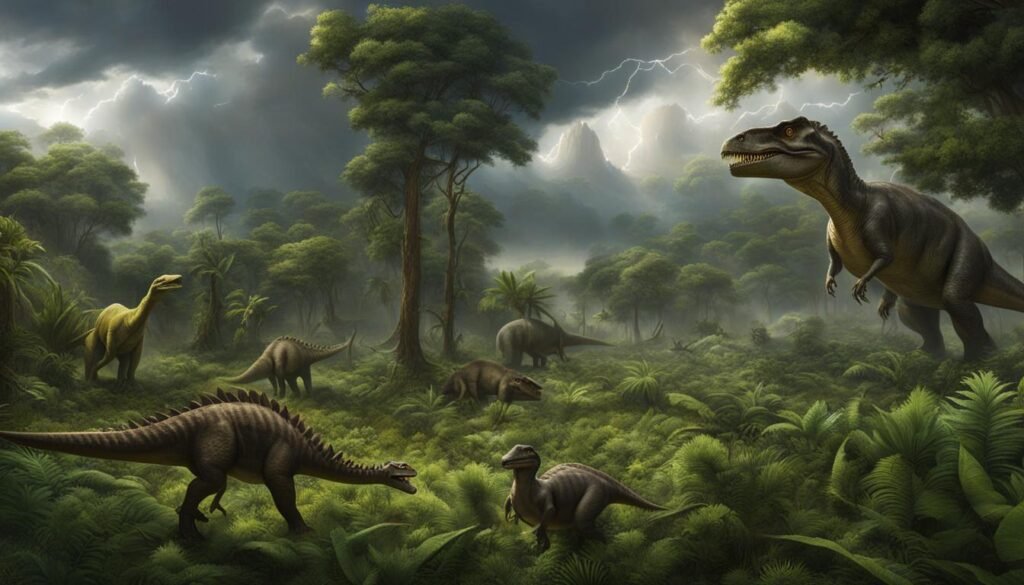
“The decline of non-avian dinosaurs has been attributed to various environmental factors.”
Climate cooling played a crucial role in shaping the fate of dinosaurs. As the global climate cooled, the availability of suitable habitats and food resources for dinosaurs changed. The cooler temperatures may have limited the range of certain species, forcing them into more confined areas and increasing competition for limited resources. Additionally, the drop in herbivorous dinosaur diversity may have been a result of the dominance of hadrosaurs, which were highly successful in outcompeting other herbivores for food.
Extinction risk was also influenced by the age of the dinosaur species. Older species were more likely to face extinction, suggesting a lack of adaptability to changing environments. This highlights the importance of evolutionary innovation and adaptation in the face of environmental pressures.
Overall, the decline of non-avian dinosaurs can be attributed to a combination of environmental factors, including climate cooling, competition from dominant herbivores, and the inability of certain species to adapt to changing conditions. Understanding these environmental influences provides valuable insights into the dynamics of dinosaur diversity and extinction.
Evaluating the Dynamics of Herbivorous Dinosaur Diversification
Understanding the dynamics of herbivorous dinosaur diversification is crucial in unraveling the mysteries of their ancient ecosystems. Advanced statistical methods, such as PyRate, provide valuable insights into the rates of species evolution and extinction over time. Through a global-scale analysis of six key herbivorous dinosaur families, researchers have uncovered intriguing patterns of diversification and decline.
In the Early Cretaceous, net diversification rates of herbivorous dinosaurs rose steadily, peaking in the middle Late Cretaceous. This period of flourishing diversity was followed by a significant decline, with net diversification rates turning negative in the late Campanian. Extinction rates surged, surpassing speciation rates, and this trend continued into the Maastrichtian. Although speciation rates only slightly decreased, the high extinction rates persisted.
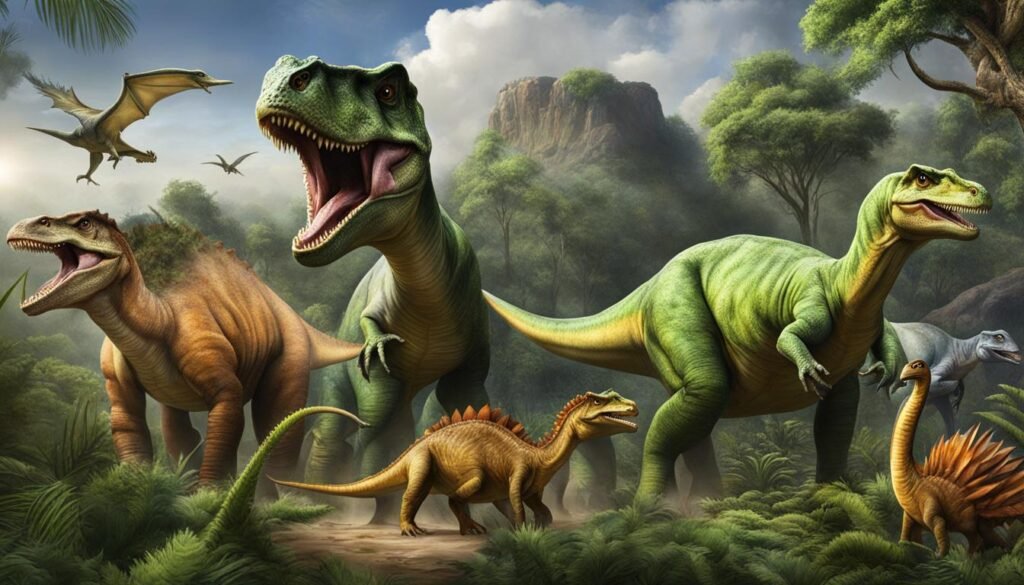
These findings suggest that multiple factors contributed to the decline of herbivorous dinosaurs. Changes in climate and a drop in herbivorous diversity likely played significant roles. The extinction risk faced by these dinosaurs may have been influenced by a lack of evolutionary novelty or adaptation to changing environments. However, further research is needed to gain a comprehensive understanding of the complex interactions that drove the diversification and decline of herbivorous dinosaurs.
Conclusion
The diversity of herbivorous dinosaurs was influenced by a range of environmental factors, including habitat partitioning, feeding behaviors, and climate changes. These factors interacted to shape the ancient ecosystems that supported these remarkable creatures. However, the decline of non-avian dinosaurs before the extinction event highlights the complexity of these interactions and their impact on dinosaur diversity.
By studying the dynamics of herbivorous dinosaur ecosystems, we can gain valuable insights into the ancient world and better understand the future of our own ecosystems. The patterns observed in the decline of herbivorous dinosaurs serve as a reminder of the delicate balance that exists in natural environments and the potential consequences of environmental changes.
Further research is needed to uncover additional details about the diversity of herbivorous dinosaur habitats and the specific environmental factors that contributed to their decline and eventual extinction. By deepening our understanding of these ancient creatures, we can continue to marvel at their diversity and learn important lessons about the fragility and resilience of life on Earth.

